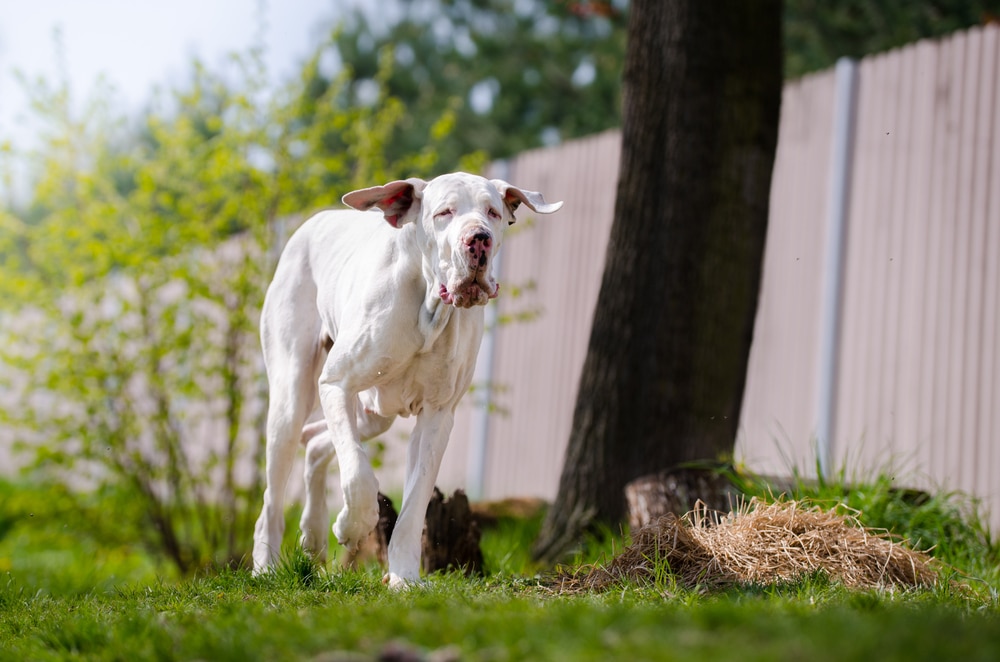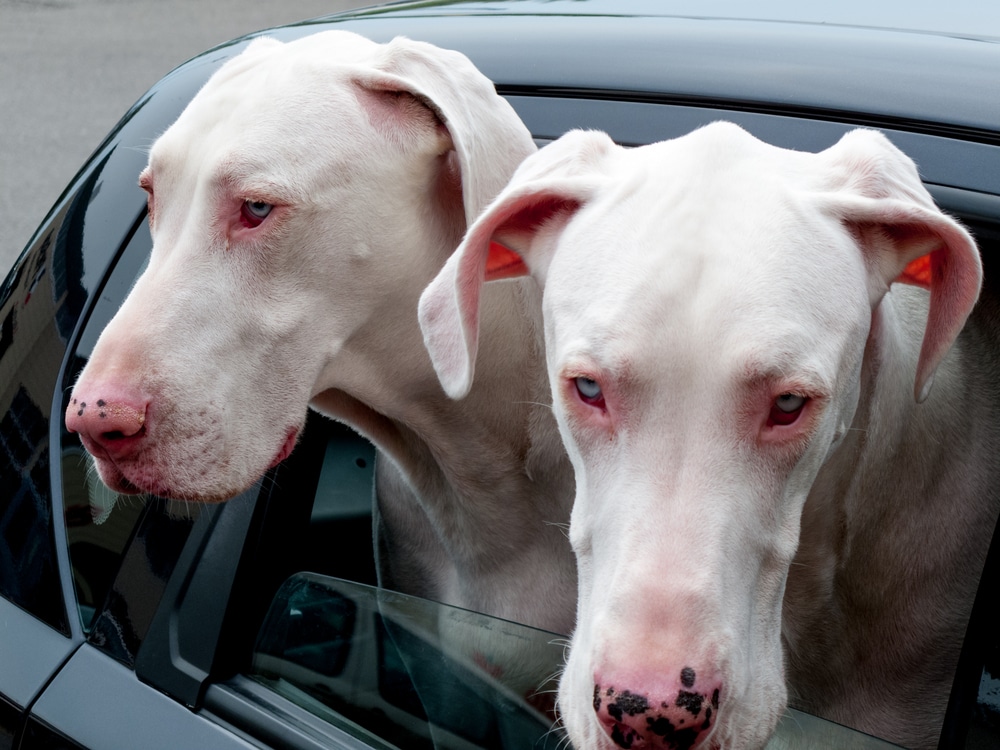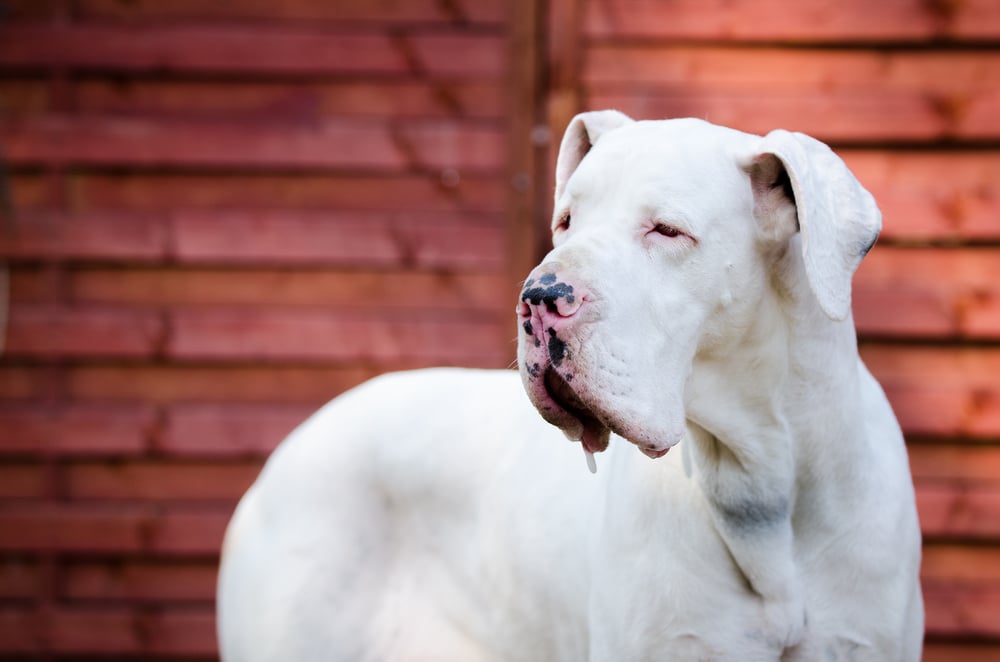“This post contains affiliate links, and I will be compensated if you make a purchase after clicking on my links.”
Last Updated on November 23, 2022
Great Dane dogs are predisposed to a number of health problems that are common in all coat colors, including the White Great Dane. However, the most common misconception about these gentle giants is that the White Danes always suffer from two health conditions: deafness and blindness, which is not always the case.
In this article, we’ll discuss these common White Great Dane health misconceptions and everything in between. Continue reading to learn more.
What is a White Great Dane?

A White Great Dane is born when both of its parents carry the Merle gene, resulting in a Great Dane that has two copies of the Merle gene. And this is why, a White Dane is also called a Double Merle.
Double Merles are considered products of bad breeding practices. This unethical breeding is also referred to as “spot to spot breeding”. In a spot-to-spot pairing, each puppy in the litter has a 25% chance of receiving both copies of their parents’ Merle gene. At times, some puppies in the litter don’t even make it and are terminated in utero.
In most cases, this happens when two Harlequin Great Danes are bred together. But Double Merles or White Great Danes can also be produced through Harlequin x Merle or Merle x Merle breeding.
The Merle Gene
The Merle gene is the gene that gives dogs two or more coat colors. The gene dilutes random sections of the dog’s coat to a lighter color. And then it leaves random patches of the original and darker color intact. It is also the gene that gives colors to a dog’s iris. The colors can range from a light blue to green, but the most common is a light blue iris.
Furthermore, the Merle gene is a dominant gene, which means a Great Dane only needs one copy of it. So, a Great Dane that has two Merle genes will have a predominantly white coat as a result of two Merle genes “diluting” almost all of the dog’s dark coat color.
The double Merle gene doesn’t only produce a white coat. It is also responsible for the lack of pigment in a Great Dane’s inner ear and eye structures, which can result to hearing and vision impairments or worse, blindness and deafness.
Are All White Great Danes Deaf and Blind?
The answer is no. Not all White Great Danes are deaf and blind. They can be deaf or blind, be deaf and blind or not deaf and blind at all. Although a White Dane with either or both issues is more common than a healthy White Dane.
Blindness
Blindness is a common Double Merle health issue. This is because, as mentioned above, the Merle gene is responsible for lightening the color of the dog’s iris. And that same gene can cause developmental defects in a White Great Dane’s eyes due to the lack of pigment.
A Double Merle’s blindness or vision impairment cannot be decided by the dog’s physical appearance alone. At times, having blue eyes doesn’t always translate to vision impairments. Because there are some blue-eyed White Danes that can see just fine. So, getting a White Dane evaluated and checked will help identify and confirm and visual deformities.
Deafness
Like blindness, Double Merle deafness is caused by the lack of pigmentation in the Dane’s inner ear. This lack of pigmentation causes hair loss on the inner ear at a very young age, usually starting at 3 weeks.
The tiny hairs in the ear that vibrates help produce sound and sends signal to the the dog’s brain. With the lack of pigmentation, the hair in the inner ear or near the ear fall off and die, resulting in either partial or full loss of hearing.
Other White Great Dane Health Issues

Deafness and blindness aren’t the only issues with Double Merles or White Great Danes. There are various other physical and mental issues that these dogs suffer due to irresponsible breeding and their flawed genetic makeup. And these health issues are the following:
1. Social Inefficiency
White Great Danes that have visual and hearing impairments can also suffer from mental health issues. Since they are either deaf or blind (or both), they cannot adapt to different situations unlike normal and healthy dogs. Since they cannot interact properly with surroundings and individuals, they find it difficult to socialize and cannot cope with normal daily activities such as regular walks.
This health issue can be curbed or prevented with proper training. However, training White Danes require a lot of persistence and patience, so you have to be ready for such responsibilities if you ever decide to adopt one.
2. Sensitive Skin
The lack of pigment in White Great Danes doesn’t only affect their coat and eyes, but also their skin. Double Merles or White Danes can inherit skin problems such as Atopic Dermatitis (AD), which is an inflammatory and itchy skin disease.
Aside from inherited skin diseases, since Double Merles have sensitive skin, even a little bit of itch on the fur can turn into a serious health concern for these dogs.
3. Skin Cancer
Since White Great Danes also lack melanin, they are more prone to sunburns and skin irritation. And such skin irritations can lead to worse problems like skin cancer.
Furthermore, White Great Danes’ exposure to the sun should be limited. And when they are doing activities under the sun, sunscreen should be applied to them.
4. Follicular Dysplasia
This is a genetic disease that leads to alopecia or hair loss. Dogs with follicular dysplasia have structural defects or abnormality in the hair shaft and follicle. White Danes that have this genetic disorder have dull and broken hairs, along with a skin infection.
The less pigment in the dog’s coat, the higher chances of this disease’s development. Furthermore, since this diseases has a progressive nature, there is no known cure for it.
5. Hereditary Defects
Aside from above mentioned issues, White Great Danes can also suffer from other inherited health problems. They can suffer from organ defects that can manifest as they grow older.
Other hereditary issues include a slower development and growth rate, which gives White Danes trouble in keeping up with puppies their age when they’re young. Other hereditary issues also include:
Microphthalmia
This inherited disease can cause or contribute to a White Great Dane’s complete blindness. White Great Danes with Microphthalmia have one or both eyeballs that appear to be abnormally small.
Although this may not seem like a huge deal in other breeds, it often leads to blindness in Double Merle dogs. As a matter of fact, the most severe cases of microphthalmia in dogs are those with two copies of the Merle gene.
Due to this, some of the puppies that are born with microphthalmia end up having their eyeballs removed due to the complications.
Congenital Cataracts
Congenital cataracts is a blinding disorder. It is an eye problem that affects the dog the moment it is born. This is another way that a White Great Dane can end up completely blind. Furthermore, this hereditary disorder is also associated with microphthalmia.
White Great Dane vs Albinos
Being a Double Merle or White Great Dane is different from being an Albino. People usually get these two conditions mixed up because in both cases, the Great Dane has a white coat. However, a White Great Dane doesn’t suffer from albinism. It suffers a pigment dilution brought about by the doubling of the Merle gene.
On the other hand, Albinism is a genetic condition in all animals, and that includes dogs. True albinism causes 100% loss of pigmentation of the eyes, coat and skin. Albino dogs are purely white and don’t have irregular spots of dark colors in their coat.
Albinism is a rare occurrence, even for Great Danes. So, if you ever see a White Great Dane, it is most likely a Double Merle and not an Albino.
Although, both Albinos and White Great Danes can suffer from similar health issues due to the lack of melanin. They both have sensitive skin and are at a higher risk of skin cancer.
How Are White Great Danes Different From Other White Dogs?
Other canine breeds with a white coat usually carry a double recessive gene. While White Great Danes carry a Double Merle gene.
The difference between the two is that, a white dog carrying a double recessive gene is, most of the time, healthy and has no genetic complications. However, a White Dane carrying a Double Merle can be born with a series of health issues and can be prone to more disabilities as they grow older.
White Great Dane Occurrence

The occurrence of White Great Danes is due to irresponsible and unethical breeding norms. This is why the American Kennel Club doesn’t recognize White Danes as an official Great Dane color.
Unethical Breeding
White Great Danes are born from the unethical breeding practice called spot to spot breeding, which we explained above.
Most cases of White Great Danes are born from breeding Harlequins together. While breeding two Harlequins together can produce Harlequin puppies, the chances of producing White Danes in the litter becomes high.
Aside from breeding two Harlequins together, White Great Danes can also be produced by the following spot to spot pairings:
- Harlequin x Merle
- Merle x Merle
- Quin x Quin (Harlequin mismarks such as Fawnequins and Merlequins)
Even thought these Great Dane coat colors are healthy, they are Danes that carry the Merle gene. And to be paired and bred together will result in higher chances of producing a litter of Double Merles.
This is why to produce Harlequins, responsible breeders pair up Harlequins with Mantle Great Danes instead. Furthermore, many Merle Great Danes can be born in Harlequin litters.
White Great Danes are actually 100% preventable. This is why spot to spot breeding have been heavily criticized and such practice is avoided by reputable breeders.
Now more than ever, unethical and illegal breeders have become more common. Not only in the USA, but all over the world. The unethical breeding practices even include breeding European Great Danes which have produced a diverging and rather less healthy trend.
The most crucial issue arising from the prevalence of illegal breeding is the tendency to affect lineage. If the practice continues, inherited health issues will be passed from generation to generation, which can alter the Great Dane’s genetic material altogether.
But of course, there are still a lot of reputable Great Dane breeders who follow ethical breeding norms and employ genetic testing to evaluate healthy litters. They uphold and keep the bloodlines intact, thus giving us the healthy and true pedigree of the Great Dane dogs we see today.
How to Know if Your White Great Dane is Fit
Double Merles that lack a lot of pigmentation on the head region experience more issues. And they are more likely to experience hearing and vision impairments because their eyes and ear structures didn’t develop correctly.
That means, the presence of irregular dark spots anywhere on the coat can be an indication of a White Great Dane that can hear or see normally.
Immune System
A White Great Dane’s immune system is as healthy as any other coat color of the breed. There are no known health issues or complications related to the dog’s immune system that is due to their coat color. And the White Dane’s lack of pigment mostly affects the dog’s eyes, ears and skin.
Nevertheless, there are Great Danes, regardless of their coat color, that have a weak immune system. But this issue can be seen through symptoms like frequent illness or infections and low energy.
Such health issue can be diagnosed by getting your Great Dane checked at the veterinarian.
Our Judgement

White Great Danes are dogs that carry a flawed genetic makeup. And we hope that this article has shed some light to what White Great Danes are and what the results of unethical breeding practices are.
A lot of unethical breeders are aware of the complications of White Danes but breed to produce them anyway. This is because the coat is considered “rare” and they get a lot of money from it. So, always remember to buy from reputable breeders only, especially if it’s your first time buying a Great Dane. Or if you can, you can always adopt as an alternative.
Despite of a White Great Dane’s health complications and everything in between, they are still worthy of love and affection, just like any other dog. It’s not going to be easy raising them, but with proper training, the right attitude and family, they can be great companions.